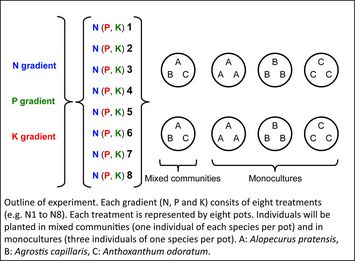Plant traits and species interactions along gradients of N:P:K stoichiometry
Plant traits and species interactions along gradients of N:P:K stoichiometry
PI: Dr. Vanessa Minden (Univ of Oldenburg / Univ of Brussels, VUB)
in cooperation with Dr. Harry Olde Venterink (Univ of Brussels, VUB)
Nutrient enrichment, as a consequence of fertilization, atmospheric deposition and modification of landscape has changed the relative importance of nutrient elements in limiting productivity, with many formerly phosphorus (P) limited aquatic systems being today nitrogen (N) limited and many terrestrial systems showing patterns of P limitation. Ecological consequences of higher nutrient input rates are shifts in ratios of nutrients and higher productivity rates, loss of species and increase in number of endangered species.
An important field of research in this context is ecological stoichiometry (ES) theory, which describes the balance of elements and energy in biological functions and processes. ES studies have mainly focused on N and P, but another macronutrient of similar importance, potassium (K), has received less attention. K is the second most abundant nutrient in leaves after nitrogen, and by that more abundant than phosphorus. Even though the total soil K pools are generally higher than those of N and P, soil-plant available K concentrations are often lower, also, organic matter in soils contains almost no K. Current studies indicate that reduction in soil K availability is related to N deposition, which makes K more sensitive to changes in land use and fertilization than either N or P. There are only few studies on the response of plants to different supply rates of N, P and K, although evidence supports that K is already a limiting nutrient in terrestrial ecosystems.
A lot of research has been done on the effects of N and P on plant growth and competition, whereas studies on the role of K in direct comparison to N and P are still missing. This study aims at exploring the effects of N, P and K on plant species interactions, and at improving our understanding of the plant trait responses that drive these competitive interactions. These traits include relative growth rate, biomass allocation patterns, morphological traits and physiological traits, such as enzyme activities. By this, the study will contribute to a scientific research area which relates organismic lifestyle with the stoichiometry of the abiotic environment. The evidences collected so far in the fields of ES have contributed greatly to the understanding of ecosystem structure and function. Nonetheless, in their review, Sardans and Peñuelas (2015) emphasize the ‘…urgent need to include K in studies of biogeochemistry and stoichiometry in terrestrial systems…’. This study addresses this urgent need.
This project consists of two parts: (i) a greenhouse experiment and (ii) a ‘meta-analysis’ study with existing datasets.
Project duration: 05/2016 - 04/2017, Research Fellowship by DFG
Project location: Vrije Universiteit Brussel, Department of Biology, Ecology and Biodiversity, Brussels, Belgium



![[Translate to English:]](/f/5/inst/biologie/ag/landeco/intern/logo.gif?v=1413960139)



